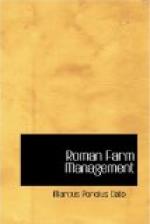If the Romans followed this wise advice they were better farmers than most of us today, for we are usually content to let the stubble dry out before ploughing.]
[Footnote 34: Was this ensilage? The ancients had their silo pits, but they used them chiefly as granaries, and as such they are described, by Varro (I, 57, 63), by Columella (I, 6), and by Pliny (XVIII, 30, 73).]
[Footnote 35: The extravagant American farmer has not yet learned to feed the leaves of trees, but in older and more economical civilizations the practice is still observed.]
[Footnote 36: Amurca was the dregs of olive oil. Cato recommends its use for many purposes in the economy of the farm, for a moth proof (XCVIII), as a relish for cattle (CIII), as a fertilizer (CXXX), and as an anointment for the threshing floor to kill weevil (XCI).]
[Footnote 37: There is a similar remedy for scratches in horses, which is traditional in the cavalry service today, and is extraordinarily efficacious.]
[Footnote 38: Cf. Pliny H.N. XVII, 267 and Fraser, The Golden Bough, XI, 177. The principle is one of magical homeopathy: as the split reed, when bound together, may cohere and heal by the medicine of the incantation, so may the broken bone.]
[Footnote 39: These examples will serve to illustrate how far Cato’s veterinary science was behind his agriculture, and what a curious confusion of native good sense and traditional superstition there was in his method of caring for his live stock. On questions of preventing malady he had the wisdom of experience, but malady once arrived he was a simple pagan. There was a notable advance in the Roman knowledge of how to treat sick cattle in the century after Cato. Cf. Varro, II, 5.
The words of the incantations themselves are mere sound and fury signifying nothing, like the “counting out” rhythms used by children at their games.]
[Footnote 40: Cato gives many recipes of household as well as agricultural economy. Out of respect for the pure food law most of them have been here suppressed, but these samples are ventured because Varro mentions them and the editor is advised that some enterprising young ladies in Wisconsin have recently had the courage to put them to the test, and vow that they ate their handiwork! As they live to tell the tale, it is assumed that the recipes are harmless.]
[Footnote 41: Cf. the following traditional formula as practised in Virginia:
A VIRGINIA RECIPE FOR CURING HAMS
“Rub each ham separately with 1/2 teaspoonful of saltpetre (use a small spoon); then rub each ham with a large tablespoonfulof best black pepper; then rub each ham with a gill of molasses (black strap is best).
Then for 1,000 lbs. of ham take
3-1/4 pecks of coarse salt,
2-1/2 lbs. of saltpetre,
2 qts. hickory ashes,
2 qts. molasses,
2 teacupfuls of red pepper.




